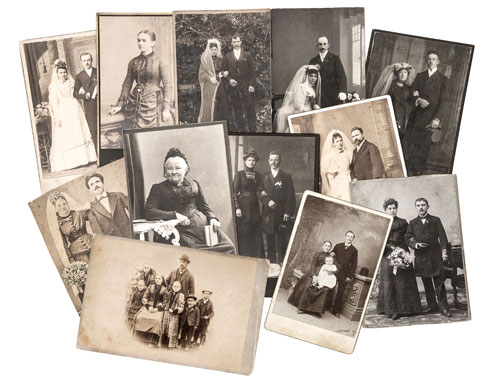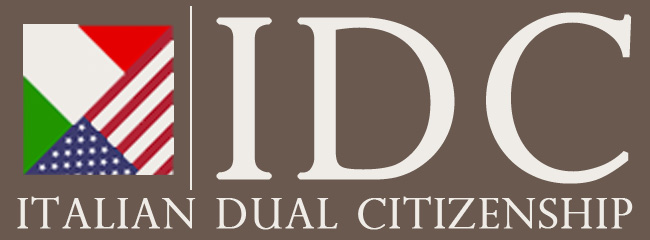
When determining whether someone is eligible to become a dual citizen of Italy, one of the most determining factors to assess eligibility is genealogy. Genealogical research can provide the necessary information to know if you are eligible by descent (Jure Sanguinis). Jure Sanguinis translates into “right of blood”. It is important to first attempt to determine where the most recent Italian-born ancestor of yours was born, as well as when they came to America, and whether they had gone through the process of nationalization. Depending on whether the ancestor was nationalized or not and how they naturalized, can have a direct affect on if you qualify and the steps that follow.
You will need to know whether the most recent Italian born ancestor was naturalized before the birth of their child that is considered to be the nearest direct connection that links you to Italy through your family. If they were not naturalized, or naturalized involuntarily, this would be the first piece of necessary information to confirm in order to determine if you qualify for Italian citizenship based on Italian law.
There are many factors to consider and steps that will need to be taken in order to locate the pertinent genealogical information that is needed for someone to have the right to claim Italian citizenship. Proper documentation, for example, is extremely important. Over the past two years the Italian consulates have became very strict with the document requirements and regularly decline applications that do not meet their requirements.
The amount of information you have available will help to determine just how easy or difficult it is going to be to prove your lineage and right to citizenship. Keep in mind that the information that is needed can be found in a host of different places, so it is important to scour your records and the records of your family to compile all of the necessary documents. Naturalization papers, or lack there of, for your Italian-born ancestor will be critical. Other less know but helpful documents to use include census records, birth certificates, ship manifests, and even draft cards. It can also be helpful to gather more information from talking to relatives and perhaps even reaching out to relatives you did not know that you had.
Getting Documentation from Italy Can Be Difficult
Be aware that searching for and obtaining documents in Italy that will be relevant to your case can be difficult. Many people, for example, are not able to fully communicate what they need because they do not have the language skills needed to speak to those working records in Italy. It would also be difficult for them to do much research on their own because they may not be able to read and understand the documents that are available since they will be in Italian.
Even those who are fluent in Italian or who are getting help from someone who was born in Italy find it very challenging to navigate the Italian ancestry system. It can not only be difficult to locate documents, but even just to find out if the record exists. In some instances, there might not be birth records on file for your ancestors, so you would have to look for other means of getting documentation. Even something as simple as a baptismal record might be able to help.
One of the important things to realize while looking for documentation in Italy is that there is no central records system. Rather than having all of the records collected in one location, they are the responsibility of each municipality or province. The records kept are supposed to cover the major life events of the people who live in that area. However, it often requires a lot of time and energy to actually find those records.
Starting the Search
Having professionals who can help with the process of finding records in Italy and other locations can be very helpful. Of course, most of the time, the search for the documents does not actually begin in Italy. Instead, you will want to delve into your own family’s documents if you have them. If you are unable to find any documentation that can help you, it’s a good idea to check the U.S. census records. These records can provide valuable information including the country in which someone was born, the year they were born, their citizenship status, their address, and their marital status.
There can be many other facts that can be discovered, as well, which can lead to even more information that will be helpful when it comes to trying to obtain your Italian citizenship via descent. A series of two letters would often be used to show the status of someone on census records. PA would be used for someone who was in the process of becoming a citizen but had not achieved it yet. AL would be used for legal aliens, while NA would be used for those who were already naturalized.
Still, it is not a good idea for anyone to put all of their faith behind the census records, as there are many times when the information found is incorrect. This could be because certain facts were not disclosed during the census interview. The interviewee may have given the misinformation mistakenly or even on purpose. In some cases, people may have feared that they would be deported, so they would leave out certain details as a means to stay safe. This is because there were many Italians who did not come into the USA using legal means. They might have also misunderstood the questions and thought that they were answering honestly.
In other instances, the census records might have incorrect information because the person who was creating the records made an error. In the case of old records, it was not always possible or easy to check the actual facts that were being given. The census takers believed what people told them, which has led to misinformation often being contained in these records.
There are even cases where people truly believed that they had become an American citizen when it wasn’t the case. They might have also misunderstood the questions and thought that they were answering honestly. Not everyone learned English immediately when they came to the United States, so some questions may have been lost in translation.
It’s important to keep in mind that the time of the naturalization can make all the difference when it comes to trying to prove Italian citizenship by descent. Typically, it will be easier for you to prove if your ancestor became an American citizen and there are naturalization records that provide the date of naturalization. This will ensure that there are no doubts.
Understanding How the Naturalization Process Once Worked
There were typically three steps involved in the naturalization process. The first step would be to declare the intention to want to be naturalized, followed by petitioning to be naturalized. Finally, the person would take an oath of allegiance to the United States. It is often possible to find the date of naturalization on the back of the petition form.
The naturalization papers provide a wide range of information and details that could be important. Information is often similar to what is on census records. It’s possible to find information regarding birth location and date, spouses, children, and similar information that can provide some clues as to where you will be able to find other paperwork that can help on your journey.
Interestingly, if your ancestor was not naturalized, it can be even more difficult to prove non-naturalization. There might not be any records available that confirm their status as an immigrant at all.
Earlier, we mentioned using draft cards to help with finding the information you need. While these can work, and so can naturalization records, there can still be some issues with them. Sometimes, the birth location that is noted will only be partially correct, or it could even be entirely incorrect. Often, people would name the province where they lived instead of the actual town where they were born.
Getting information on which province they were from is certainly helpful. However, it is still only part of the story, and it can be confusing. It will often require finding additional documentation that can provide the correct location. Looking for more documents will, naturally, take more time.
Ship manifests often have this issue as well. However, they often prove to be more accurate and will include the name of the town and not the province. Something to remember is that if they came to the United State with other family members, the place of origin listed might be the origin of those relatives and not the ancestor you are researching. Still, if the information on their relatives is available, it can provide some valuable clues in finding out more about the ancestor you are researching.
This is because, quite often, family members would stay together or at least in the same area, when they came to the United States. The information provided about those other people can be helpful when it comes to tracking down information that is relevant to your own needs.
Modified Names
There are instances when it is seemingly impossible to find any records. One of the common reasons for this is that when people came to the United States, their name would be changed when they came into the country. They might have been modified or translated incorrectly, which means you might ultimately find an ancestor that had a different name than what you have. When you are able to find their actual name, you may be able to start to narrow down where they were from if you don’t have other information. However, it is not always a guarantee. Some names are very common and they are not going to help you find what you need. This could mean that you look at some ship manifests and find several names that match your ancestor. How do you know which one is your actual ancestor?
For reasons like this, it is important to search for multiple records that can provide you with more clues and information that you need. This is one of the reasons it can take so long to find exactly what you need. One clue leads to the next and so on.
You Need to Find the Documentation Even if It Takes Time
If you are going to concretely prove that you are eligible for citizenship in Italy, you need to make sure that you get the records and documents that are needed, even though it can take time and effort to gather them. When you find the documents, you still need to make sure that you are able to verify the information to the Italian consulates standards.
If you are trying to find a male ancestor, the most important information will generally be the date of birth and the place of birth, as well as if he naturalized and the date that the naturalization happened. If the ancestor was female, you will need this same information, as well as when she came to the United States and whether only her husband naturalized alone or with her. In some cases, she might not have had the Italian citizenship revoked since America, at certain times, ruled that a woman’s citizenship was based on her husband’s citizenship status.
Often, an Italian male who became naturalized as a citizen in the United States would automatically make their wife, minor children, and any children born after naturalization citizens of the United States. According to Italian law, even if he did not fill out any paperwork to renounce his Italian citizenship at the time, it would be automatically considered renounced by Italy when he became a USA citizen. However, if is wife never renounced her citizenship, she would not have lost her Italian citizenship along with her husband. The 1948 Judicial Case is a process that will allow for citizenship to be obtained in this manner from a female ancestor.
Finding Information on Your Own
It is certainly possible to start your journey to find the information you need on your own. If your family has all of the records and information needed, then you are off to a great start. However, that’s rarely that case, and before long, you will start to head down a rabbit hole looking for the right clues to find documentation and to piece it all together. There are some websites available that can help to make things easier for you.
One of the most well-known is Ancestry.com. The site contains public records from the United States and makes it possible for people who upload their family tree to connect with others who share a common ancestor. Another site to consider is FamilySearch.org. This website works similarly to Ancestry.com, but you can create a free account and create a family tree.
You might also want to check out Ellis Island Passenger Search, which has archives of people who came through Ellis Island. It could be possible to find your ancestor who came to the United States, but it can sometimes be difficult. This is especially true if their name was changed when they arrived.
The previous sites are all available in English. However, you can also visit Antenati.san.benicultuali.it, which is mostly in Italian, although there is some information in English and Spanish. The resource provides records that have been digitized in Italy. While it can be a benefit, you will have to keep in mind that not all records in all of the provinces have been digitized at this time. It is an ongoing process.
Getting Help from the Professionals
Finding all of this information on your own is going to be quite difficult and time-consuming in many cases. This is true even when you are using quality sites and resources like those listed above. However, you can make things much easier for yourself when you choose to contact our Italian citizenship professionals who will be able to take care of the entire process for you from start to finish.





